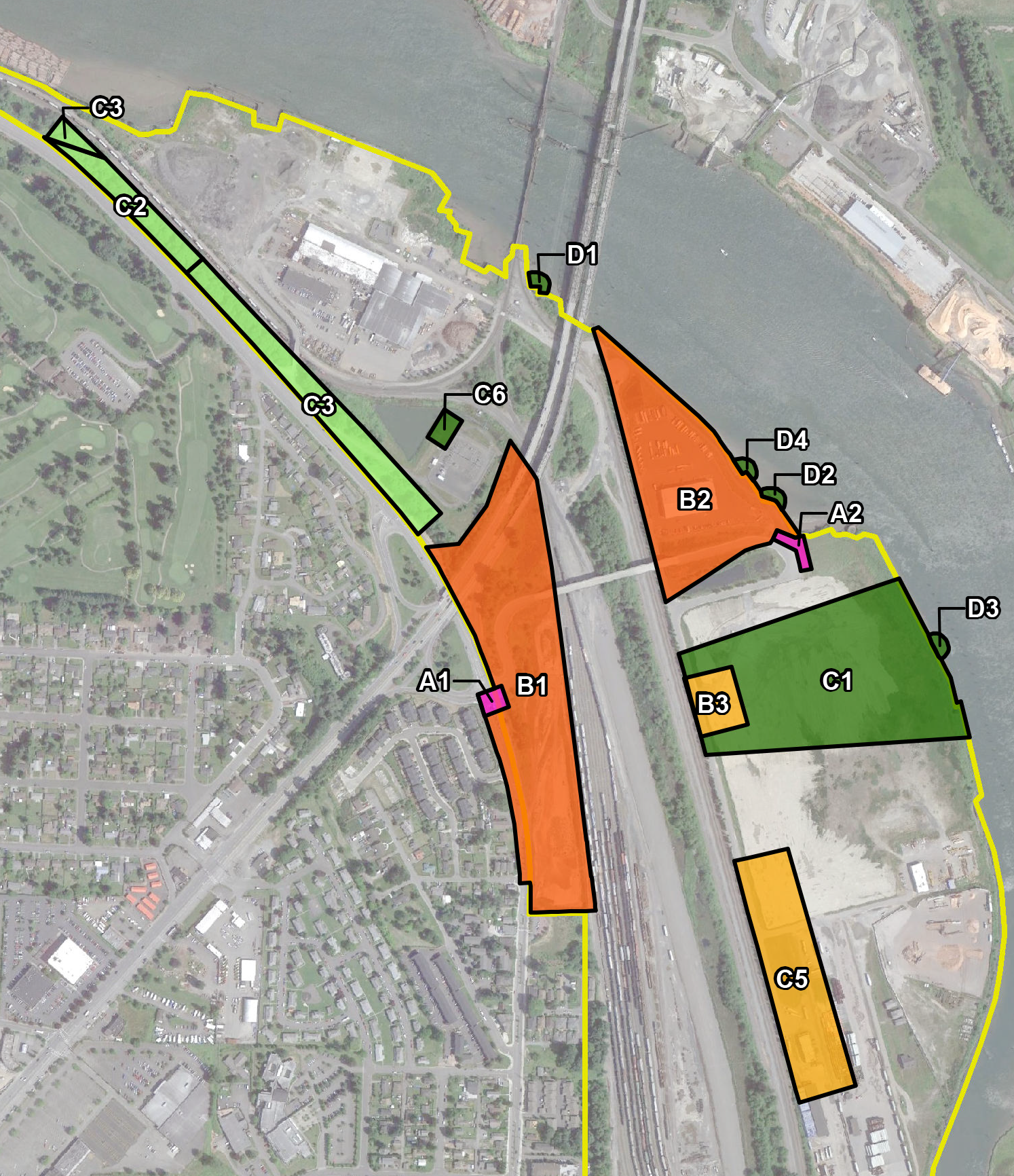Cleaning up the Everett Smelter lowland area
The lowland area of the Everett smelter site is east of East Marine View Drive. It was a tideflat and floodplain of the Snohomish River. While the smelter was running, the area was undeveloped except for the railroad, and was later used for industry. Our investigations found arsenic, lead, and mercury in this area that must be cleaned up. These contaminants exist in soil, shallow and deep groundwater, and in limited areas of the sediment below outfalls along the shoreline.
We finalized the Cleanup Action Plan for the lowland area in 2016. Based on the data, we divided the lowland into fourteen areas needing cleanup. We are using several cleanup methods, including soil removal, capping, and monitored natural attenuation for cleanup. In some areas, we will require institutional controls — measures to limit or prohibit activities that might result in exposure to contamination. In other areas, we will allow natural processes to reduce the contamination, while monitoring surface water and groundwater quality to confirm that it's working.
Cleanup progress
The cleanup site is divided into Uplands (residential) and Lowlands cleanup areas. The two areas are on different cleanup schedules.
Cleanup for the lowland area began in 2019. Ecology is working on the design of an engineered cap and stormwater routing design for Area B1. The Engineering Design Report will be out for public comment in 2025 or 2026.
Work completed
-
We finished cleanup in area A1 in 2018.
-
We disconnected the underdrain system in area C5 during the development of parcels in 2019.
-
Ecology and the City of Everett installed a lining inside cracked pipes to prevent contaminated groundwater from entering the Snohomish River in area B2. This work was completed in 2024.
-
Ecology also partnered with the city in 2024 to install fencing along East Marine View Drive (area C2 and C3) at the top of the steep slope above the railroad tracks. This fencing limits access to contaminated soil on the steep slope.
Cleanup Action Plan for the lowland area

Read a text summary of the areas, or read detailed descriptions in the Cleanup Action Plan. The BNSF railway property is not included in the lowlands cleanup.
The Cleanup Action Plan addresses 14 contaminated areas in the lowlands part of the site. The lettered groups are based on proximity to the river and how the contamination in the area interacts with groundwater. We plan to use different cleanup technologies, and we may use more than one technology at some locations.
Our priority is removing contamination sources. We plan to phase work as funding allows.
Cleanup methods
-
Soil removal: Workers will excavate contaminated material from A1 and A2 and transport it offsite for disposal at an approved facility.
-
Capping: In areas B1, B2, B3, and C5, a natural or synthetic material over contaminated soil to keep rainwater from seeping in. This reduces the potential for human exposure.
-
Workers will install new caps B1 and B2
-
Property owners must maintain existing caps at B3, C5, and C6
-
-
Permeable reactive barrier: At B2, workers will inject chemicals into the ground. These chemicals form a “wall of treatment” that reacts with arsenic as it passes through the treatment area. Arsenic is then drawn out of groundwater and into the soil where it stays in place.
-
Institutional controls: At C1–C3, C6, and D1–D4, fences, permit requirements, restrictive covenants, and zoning regulations will minimize the potential for human exposure. These controls do not physically change the site or reduce contamination levels.
-
Monitored natural attenuation will be used at C1, C6, and D1–D4. The plan is to monitor the water quality of surface water and groundwater to confirm that natural processes are reducing the contamination.
All sites will be monitored after cleanup actions are completed to confirm that the cleanup remains effective.
History
During the smelter operation, the lowland area was an undeveloped flood plain/tide flats area. In 1914, after the facility closed, Weyerhaeuser acquired most of the land in the lowland area. Over the years, Weyerhaeuser constructed and operated a large wood products manufacturing complex.
When Weyerhaeuser decommissioned its timber industry operations within the lowlands area in the 1980s and 1990s, it provided a good deal of environmental data. Ecology oversaw cleanup of contamination from the timber operation on the three former Weyerhaeuser properties that are within the Everett smelter lowland area (see "Related Links" below). The timber operation contamination is not being addressed in our Everett smelter lowland area cleanup plans. The cleanup activities for the Everett smelter site will only address metals contamination (mainly arsenic and lead) from the smelter operation.
Using the Asarco settlement funds, Ecology investigated the nature and extent of the smelter contamination in the lowlands area and reported it in the Supplemental Remedial Investigation Report (38.1 mb). We developed cleanup options and evaluated them in the Feasibility Study report (8.9 mb). We finalized both reports in February 2016. You can view them and other cleanup documents in the Everett Smelter Plume online document library.
Related links
Contact information
Sandra Matthews
Lowlands Site Manager
Sandra.Matthews@ecy.wa.gov
425-223-1999


